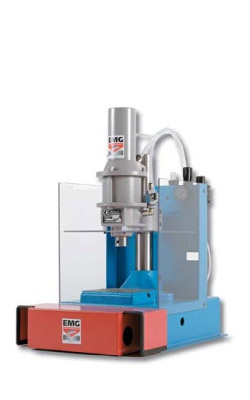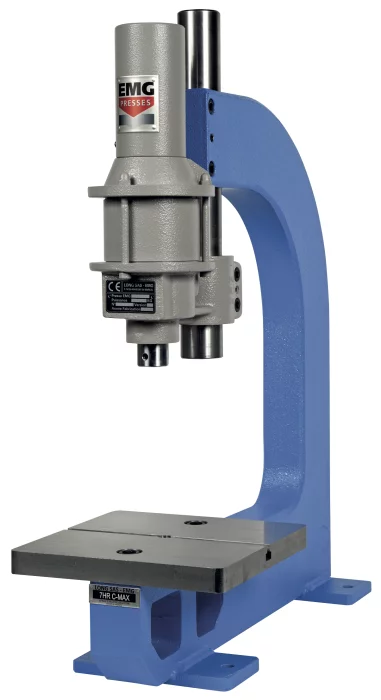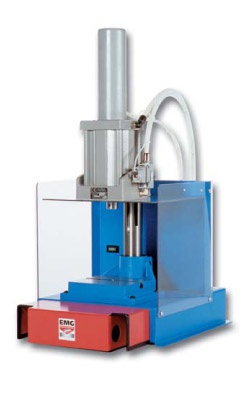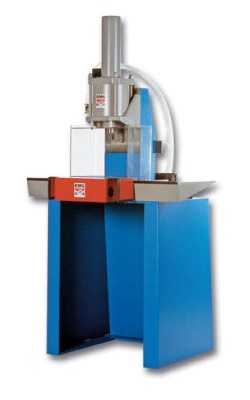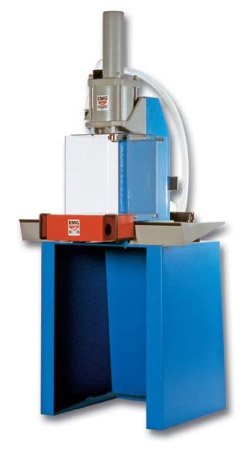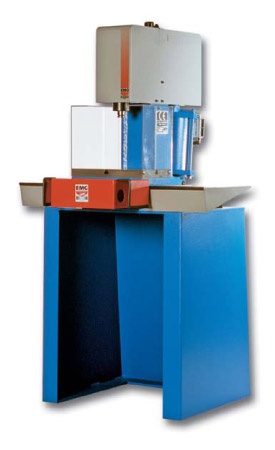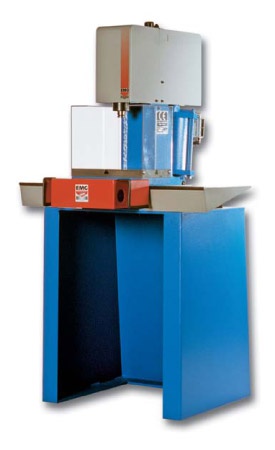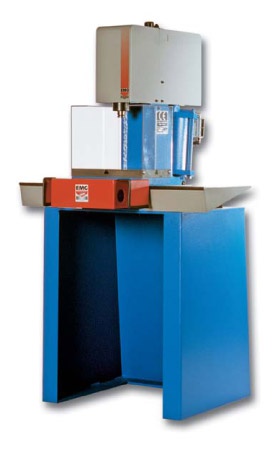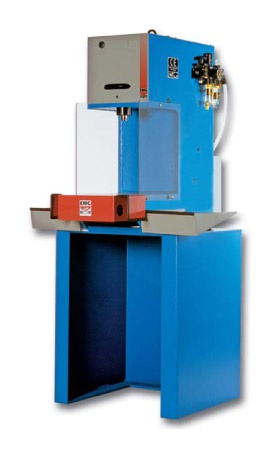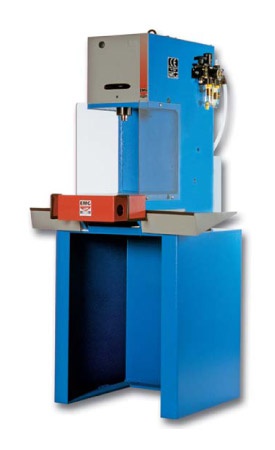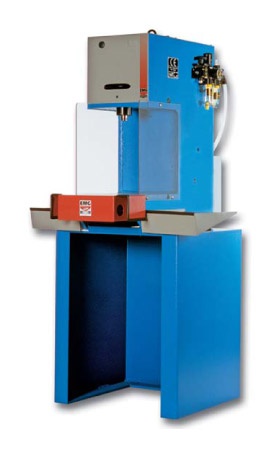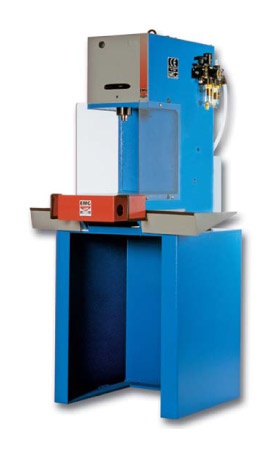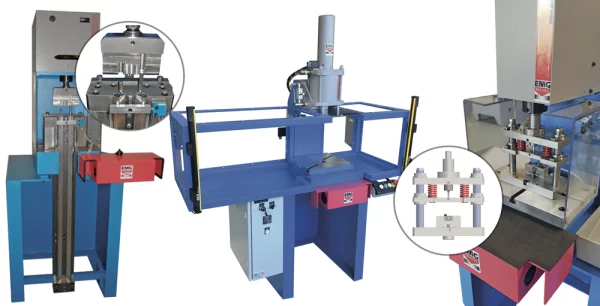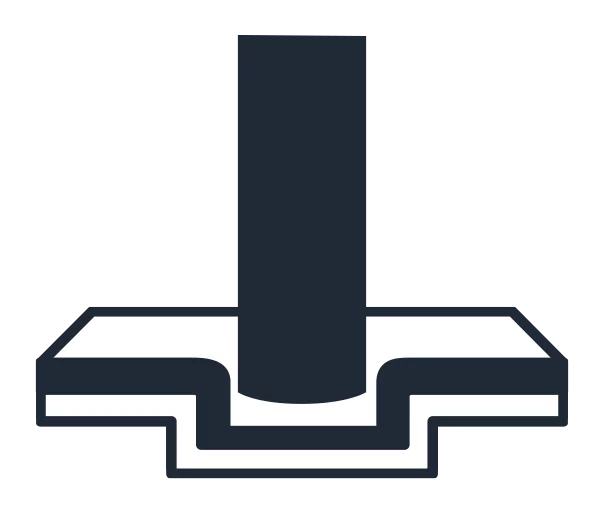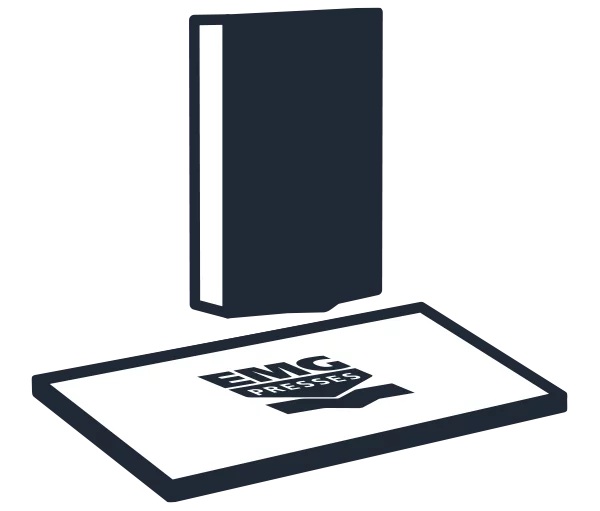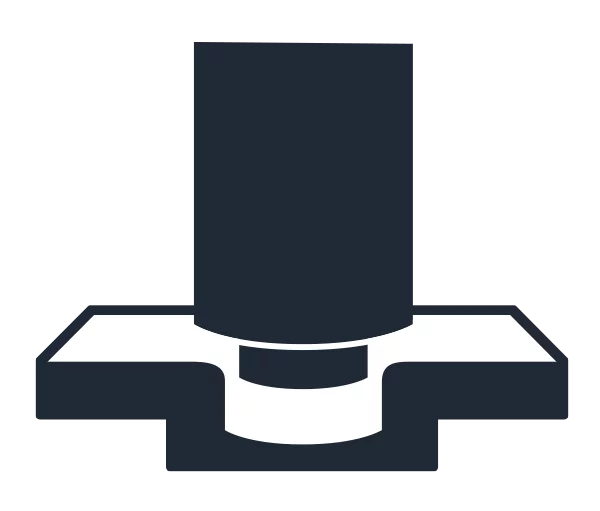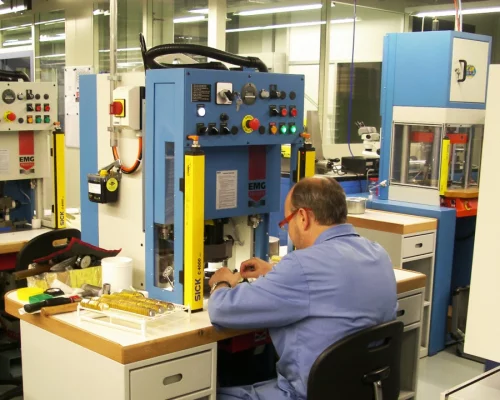Pneumatic bench presses
The range of pneumatic EMG presses effectively complements the manual presses and is the perfect answer to the customer's requirements when the output is higher and/or the power required is greater. Their powers are from 800 to 13,000 lbs. This power is indicated with a pressure of 87 psi and is proportionally adjustable as standard from 44 to 87 psi.
The ergonomics of the press has been thought out to keep the operator comfortable at his workstation even during repetitive operations. A quick adjustment allows an easy use and a very good quality/price ratio makes our pneumatic presses privileged tools in your workshops.
2 pneumatic presses range :
• Direct push double effect presses from 800 psi to 1.1 t : 2PHR - 6PHR - 6PHR C-MAX - 8PHR - 1T - 1T LP - 2T-DC - 2T-DC LP
• Indirect push double effect presses from 2.2 t to 6.6 t : 2T - 3T - 4,3T - 2T LP - 3T LP - 4,3T LP - 6T LP
| Power800 lbs |
| Stroke0 » 1.9 inch |
| Swan-neck depth3.7 inch |
| Clear height0.7 » 9.8 inch |
| Lower speed5.9 mm/sec. |
| Air Consumption0.16 gal |
| Weight56 lbs |
| Power800 lbs |
| Stroke0 » 1.9 inch |
| Swan-neck depth13.7 inch |
| Clear height2.3 » 10.6 inch |
| Lower speed5.9 mm/sec. |
| Air Consumption0.16 gal |
| Weight210 lbs |
| Power2,200 lbs |
| Stroke0 » 3.9 inch |
| Swan-neck depth3.9 inch |
| Clear height5.5 » 7.8 inch |
| Lower speed3.9 mm/sec. |
| Air Consumption0.9 gal |
| Weight275 lbs |
| Power2,200 lbs |
| Stroke0 » 3.9 inch |
| Swan-neck depth7 inch |
| Clear height11.8 inch |
| Lower speed3.9 mm/sec. |
| Air Consumption0.9 gal |
| Weight330 lbs |
| Power4,400 lbs |
| Stroke0 » 2.7 inch |
| Swan-neck depth4.3 inch |
| Clear height7.8 inch |
| Lower speed2.9 mm/sec. |
| Air Consumption1.4 gal |
| Weight330 lbs |
| Power6,600 lbs |
| Stroke0 » 2.1 inch |
| Swan-neck depth4.3 inch |
| Clear height7 inch |
| Lower speed1.9 mm/sec. |
| Air Consumption1.4 gal |
| Weight330 lbs |
| Power9,500 lbs |
| Stroke0 » 1,5 inch |
| Swan-neck depth4.3 inch |
| Clear height6.8 inch |
| Lower speed1.4 mm/sec. |
| Air Consumption1.4 gal |
| Weight330 lbs |
| Power4,400 lbs |
| Stroke0 » 2.7 inch |
| Swan-neck depth7 inch |
| Clear height12.4 inch |
| Lower speed2.9 mm/sec. |
| Air Consumption1.4 gal |
| Weight440 lbs |
| Power6,600 lbs |
| Stroke0 » 2.1 inch |
| Swan-neck depth7 inch |
| Clear height11.8 inch |
| Lower speed1.9 mm/sec. |
| Air Consumption1.4 gal |
| Weight440 lbs |
| Power9,500 lbs |
| Stroke0 » 1,5 inch |
| Swan-neck depth7 inch |
| Clear height11.6 inch |
| Lower speed1.4 mm/sec. |
| Air Consumption1.4 gal |
| Weight440 lbs |
| Power13,000 lbs |
| Stroke0 » 1,9 inch |
| Swan-neck depth7 inch |
| Clear height12 inch |
| Lower speed1.18 mm/sec. |
| Air Consumption2.6 gal |
| Weight510 lbs |
Applications
MAIN FEATURES
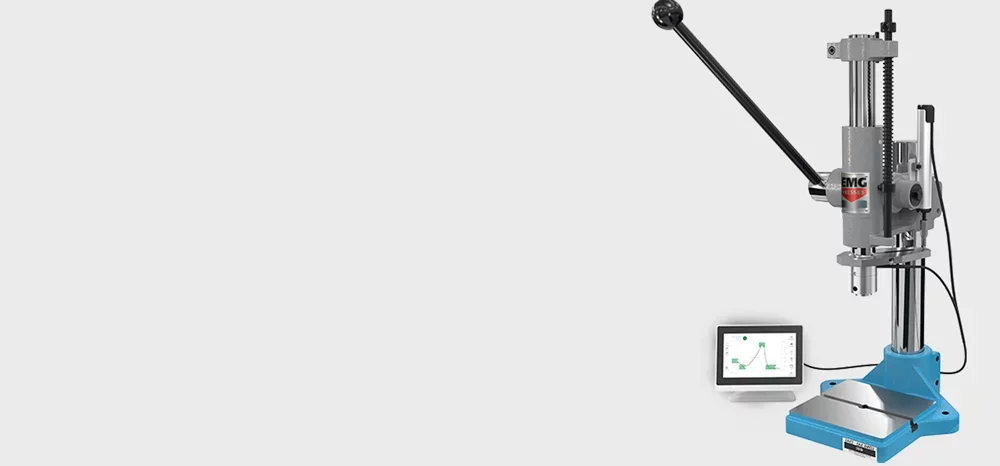
Force / stroke monitoring
MANUAL AND PNEUMATIC PRESSES
EMG offers all types of force and/or displacement management thanks to force and displacement sensor solutions adapted to each need, for 100% part control.
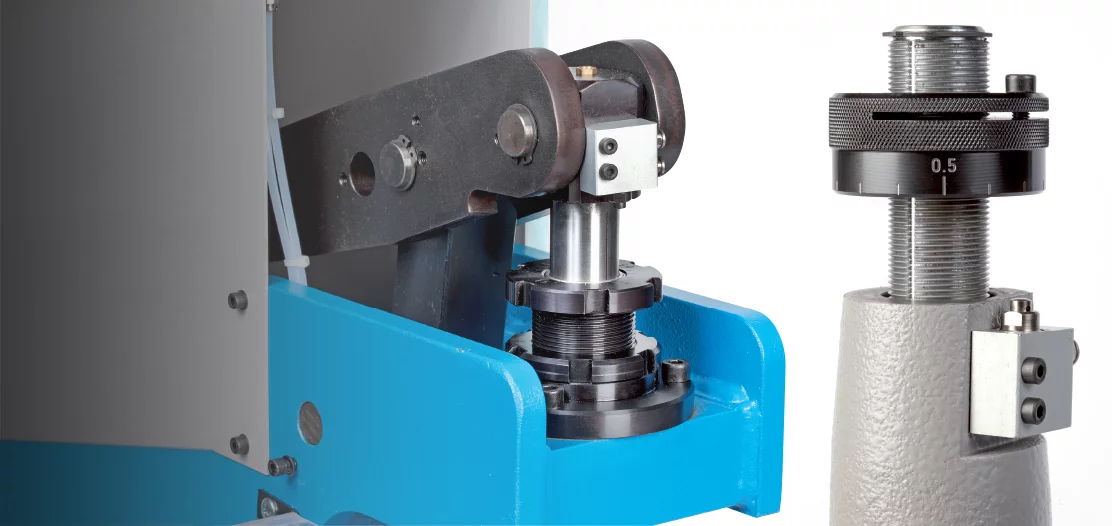
Stroke adjustment
OF PNEUMATIC PRESSE
The stroke of our presses can be adjusted using a precision mechanical nut, graduated to 0.004 inch, with a locking device to ensure perfect cycle repeatability.
The range of EMG pneumatic presses completes the range of manual presses and perfectly complies with the customer requirements when the stroke rates are more significant and/or the power to be restored is high.
Single or continuous stroke, the range of EMG pneumatic presses is integrated into the workstations or production line, ensuring ergonomy, operator safetyand process reliability.
These presses are robust, accurate, flexible and ergonomic. These are frequently used for assembly, connections of rings or bearings, small forms, various crimping operations, etc...
Features :
These presses are robust, accurate, flexible and ergonomic. These are frequently used for assembly, connections of rings or bearings, small forms, various crimping operations, etc.
- Slider adjusted and locked for rotation, ensuring longevity and precision.
- Automatic load of the cylinder when controls released
- Quick and reliable adjustment, with locking ensuring perfect repetitiveness.
- Accurate adjustment of bottom dead center by a mechanical stop ensuring the repetitiveness
- of the cycle.
- Cast iron FGL 250 or mechanically welded frame ensuring robustness and rigidity.
- No maintenance, no greasing.
- Paint: Sky blue RAL 5015 frame - Platinum grey RAL 7036 press head.
All cylinders are manufactured by EMG and have millions of users across the world which testifies to their exceptionally good quality. The slider is made of chromated steel set on rings and locked for rotation by a key. The piston slides effortlessly in the chromated cylinder, seals ensuring perfect sealing of the cylinder.
The power of our presses is indicated with a pressure at 87 psi and is proportionally adjustable as standard from 44 to 87 psi.
Example: the 6PHR press delivers 800 lbs at 87 psi, and therefore 400 lbs at 44 psi, 530 lbs at 58 psi and 660 lbs at 72 psi.
They have a small footprint despite having a large throat depth, a large headroom, a stroke of up to 3.9 inch and an air consumption of between 0.16 and 2.6 gal. We provide technical assistance in selecting and adapting the characteristics of our presses to your specific needs, and we can even make special presses and equipment to measure.
Pneumatic presses are suitable for low tonnage pressing operations and for small and medium series production.
MAIN CHARCTERISTICS:
- Precision and longevity with the adjusted slider locked for rotation
- Automatic load of the cylinder when controls released
- Quick and reliable adjustment, with locking ensuring perfect repetitiveness.
- Accurate adjustment of bottom dead center by a mechanical stop ensuring the repetitiveness of the cycle.
- Cast iron FGL 250 or mechanically welded frame ensuring robustness and rigidity.
- No maintenance, no greasing
APPLICATIONS
Pneumatic presses are used in many industrial applications for mechanical stamping, cutting or riveting. A pneumatic press will offer a higher force than a manual press, which gives it greater versatility.
Indeed, a pneumatic press with a force of up to 6.6 tons can stamp plastic materials and also many metals. They are also used to cut the various shapes needed in the production process of many mechanical parts as well as to rivet parts that need to be held together.
How does a pneumatic press work ?
The operation of a pneumatic press is similar to the operation of a manual press. The manual action of the operator is replaced by the action of a pneumatic cylinder. The cylinder activates air (not gas). The air is forced into a tube in which they receive the pressure. The precision of the operation is as high as it is simple to use this industrial tool. As efficient as hydraulic presses, pneumatic presses are commonly used in industry.

